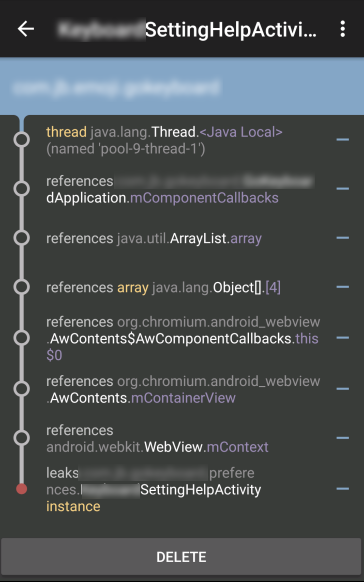Android 5.1 WebView記憶體洩漏問題及解決
問題背景
在排查專案記憶體洩漏過程中發現了一些由WebView引起的記憶體洩漏,經過測試發現該部分洩漏只會出現在android 5.1及以上的機型。雖然專案使用WebView的場景並不多,但秉承著一個洩漏都不放過的精神,我們肯定要把它給解決了。
遇到的問題
專案中使用WebView的頁面主要在FAQ頁面,問題也出現在多次進入退出時,發現記憶體佔用大,GC頻繁。使用LeakCanary觀察發現有兩個記憶體洩漏很頻繁:

我們分析一下這兩個洩漏:
從圖一我們可以發現是WebView的ContentViewCore中的成員變數mContainerView引用著AccessibilityManager的mAccessibilityStateChangeListeners導致activity不能被回收造成了洩漏。
引用關係:mAccessibilityStateChangeListeners->ContentViewCore->WebView->SettingHelpActivity
從圖二可以發現引用關係是: mComponentCallbacks->AwContents->WebView->SettingHelpActivity
問題分析
我們找找mAccessibilityStateChangeListeners 與 mComponentCallbacks是在什麼時候註冊的,我們先看看mAccessibilityStateChangeListeners
AccessibilityManager.java
private final CopyOnWriteArrayList<AccessibilityStateChangeListener>
mAccessibilityStateChangeListeners = new CopyOnWriteArrayList<>();
/**
* Registers an {@link AccessibilityStateChangeListener} for changes in
* the global accessibility state of the system.
*
* @param 上面這幾個方法是在AccessibilityManager.class中定義的,根據方法呼叫可以發現在ViewRootImpl初始化會呼叫addAccessibilityStateChangeListener 新增一個listener,然後會在dispatchDetachedFromWindow的時候remove這個listener。
既然是有remove的,那為什麼會一直引用著呢?我們稍後再分析。
我們再看看mComponentCallbacks是在什麼時候註冊的
Application.java
public void registerComponentCallbacks(ComponentCallbacks callback) {
synchronized (mComponentCallbacks) {
mComponentCallbacks.add(callback);
}
}
public void unregisterComponentCallbacks(ComponentCallbacks callback) {
synchronized (mComponentCallbacks) {
mComponentCallbacks.remove(callback);
}
}上面這兩個方法是在Application中定義的,根據方法呼叫可以發現是在Context 基類中被呼叫
/**
* Add a new {@link ComponentCallbacks} to the base application of the
* Context, which will be called at the same times as the ComponentCallbacks
* methods of activities and other components are called. Note that you
* <em>must</em> be sure to use {@link #unregisterComponentCallbacks} when
* appropriate in the future; this will not be removed for you.
*
* @param callback The interface to call. This can be either a
* {@link ComponentCallbacks} or {@link ComponentCallbacks2} interface.
*/
public void registerComponentCallbacks(ComponentCallbacks callback) {
getApplicationContext().registerComponentCallbacks(callback);
}
/**
* Remove a {@link ComponentCallbacks} object that was previously registered
* with {@link #registerComponentCallbacks(ComponentCallbacks)}.
*/
public void unregisterComponentCallbacks(ComponentCallbacks callback) {
getApplicationContext().unregisterComponentCallbacks(callback);
}根據洩漏路徑,難道是AwContents中註冊了mComponentCallbacks未反註冊麼?
只有看chromium原始碼才能知道真正的原因了,好在chromium是開源的,我們在android 5.1 Chromium原始碼中找到我們需要的AwContents(自備梯子),看下在什麼時候註冊了
AwContents.java
@Override
public void onAttachedToWindow() {
if (isDestroyed()) return;
if (mIsAttachedToWindow) {
Log.w(TAG, "onAttachedToWindow called when already attached. Ignoring");
return;
}
mIsAttachedToWindow = true;
mContentViewCore.onAttachedToWindow();
nativeOnAttachedToWindow(mNativeAwContents, mContainerView.getWidth(),
mContainerView.getHeight());
updateHardwareAcceleratedFeaturesToggle();
if (mComponentCallbacks != null) return;
mComponentCallbacks = new AwComponentCallbacks();
mContext.registerComponentCallbacks(mComponentCallbacks);
}
@Override
public void onDetachedFromWindow() {
if (isDestroyed()) return;
if (!mIsAttachedToWindow) {
Log.w(TAG, "onDetachedFromWindow called when already detached. Ignoring");
return;
}
mIsAttachedToWindow = false;
hideAutofillPopup();
nativeOnDetachedFromWindow(mNativeAwContents);
mContentViewCore.onDetachedFromWindow();
updateHardwareAcceleratedFeaturesToggle();
if (mComponentCallbacks != null) {
mContext.unregisterComponentCallbacks(mComponentCallbacks);
mComponentCallbacks = null;
}
mScrollAccessibilityHelper.removePostedCallbacks();
mNativeGLDelegate.detachGLFunctor();
}在以上兩個方法中我們發現了mComponentCallbacks的蹤影,
在onAttachedToWindow的時候呼叫mContext.registerComponentCallbacks(mComponentCallbacks)進行註冊,
在onDetachedFromWindow中反註冊。
我們仔細看看onDetachedFromWindow中的程式碼會發現
如果在onDetachedFromWindow的時候isDestroyed條件成立會直接return,這有可能導致無法執行mContext.unregisterComponentCallbacks(mComponentCallbacks);
也就會導致我們第一個洩漏,因為onDetachedFromWindow無法正常流程執行完也就不會呼叫ViewRootImp的dispatchDetachedFromWindow方法,那我們找下這個條件什麼時候會為true
/**
* Destroys this object and deletes its native counterpart.
*/
public void destroy() {
mIsDestroyed = true;
destroyNatives();
}發現是在destroy中設定為true的,也就是說執行了destroy()就會導致無法反註冊。我們一般在activity中使用webview時會在onDestroy方法中呼叫mWebView.destroy();來釋放webview。根據原始碼可以知道如果在onDetachedFromWindow之前呼叫了destroy那就肯定會無法正常反註冊了,也就會導致記憶體洩漏。
問題的解決
我們知道了原因後,解決就比較容易了,就是在銷燬webview前一定要onDetachedFromWindow,我們先將webview從它的父view中移除再呼叫destroy方法,程式碼如下:
@Override
protected void onDestroy() {
super.onDestroy();
if (mWebView != null) {
ViewParent parent = mWebView.getParent();
if (parent != null) {
((ViewGroup) parent).removeView(mWebView);
}
mWebView.removeAllViews();
mWebView.destroy();
mWebView = null;
}
}還有個問題,就是為什麼在5.1以下的機型不會記憶體洩漏呢,我們看下4.4的原始碼AwContents
/**
* @see android.view.View#onAttachedToWindow()
*
* Note that this is also called from receivePopupContents.
*/
public void onAttachedToWindow() {
if (mNativeAwContents == 0) return;
mIsAttachedToWindow = true;
mContentViewCore.onAttachedToWindow();
nativeOnAttachedToWindow(mNativeAwContents, mContainerView.getWidth(),
mContainerView.getHeight());
updateHardwareAcceleratedFeaturesToggle();
if (mComponentCallbacks != null) return;
mComponentCallbacks = new AwComponentCallbacks();
mContainerView.getContext().registerComponentCallbacks(mComponentCallbacks);
}
/**
* @see android.view.View#onDetachedFromWindow()
*/
public void onDetachedFromWindow() {
mIsAttachedToWindow = false;
hideAutofillPopup();
if (mNativeAwContents != 0) {
nativeOnDetachedFromWindow(mNativeAwContents);
}
mContentViewCore.onDetachedFromWindow();
updateHardwareAcceleratedFeaturesToggle();
if (mComponentCallbacks != null) {
mContainerView.getContext().unregisterComponentCallbacks(mComponentCallbacks);
mComponentCallbacks = null;
}
mScrollAccessibilityHelper.removePostedCallbacks();
if (mPendingDetachCleanupReferences != null) {
for (int i = 0; i < mPendingDetachCleanupReferences.size(); ++i) {
mPendingDetachCleanupReferences.get(i).cleanupNow();
}
mPendingDetachCleanupReferences = null;
}
}我們可以看到在onDetachedFromWindow方法上是沒有isDestroyed這個判斷條件的,這也證明了就是這個原因造成的記憶體洩漏。
問題的總結
使用webview容易造成記憶體洩漏,如果使用沒有正確的去釋放銷燬很容易造成oom。webview使用也有很多的坑,需多多測試。
使用中遇到問題可以參考該連結:Android之Android WebView常見問題及解決方案彙總 http://www.cnblogs.com/lee0oo0/p/4026774.html

